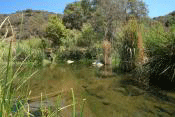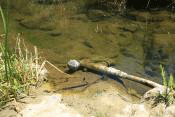Wireless Science
Air Date: Week of January 18, 2008

The creek in the Santa Margarita Ecological Reserve in San Diego County, California that hosts the water quality probes. (Photo: Monika Braun)
It’s fast, it’s reliable, and it’s transforming how scientists do their research. IEEE Spectrum Radio’s Jean Kumagai reports on a wireless sensor network called HP-WREN.
Transcript
GELLERMAN: To probe nature’s closest-held secrets and gather data, scientists sometimes have to trek into remote and forbidding places. But once there – they’ve got another problem - getting all that data home. As Spectrum Radio’s Jean Kumagai reports, researchers now have a new, faster system to retrieve and transmit data – that just might transform the way they do science.
[SOUND OF WALKING ON GRAVEL, MAN SAYS ‘BE CAREFUL, THERE’S SOMETIMES SNAKES THERE . . . ‘]
KUMAGAI: Hans Werner Braun picks his way along a bramble-covered path at the Santa Margarita Ecological Reserve in San Diego County, California. He stops at the edge of a cliff, and looks down to a river below.
[SOUND FROM BABBLING BROOK]
KUMAGAI: Braun, a computer scientist at the University of California San Diego, says that this is one of the last free-flowing rivers in Southern California. The water burbles along through a narrow, cactus-studded gorge. It’s the dry season, so the river is more of a shallow creek at the moment. The idea is to keep the river and its surroundings as pristine and close to their natural state as possible. That’s where Braun comes in.

One of the probes used to sample the stream.(Photo: Monika Braun)
KUMAGAI: Over the past seven years, Braun and a few colleagues have built a high-speed wireless network linking up dozens of sites throughout San Diego County. It’s called the High Performance Wireless Research and Education Network, or HPWREN, and it allows researchers to monitor the tiniest facets of Santa Margarita’s ecosystem.
BRYANT: There’s little fishes in here, craw-dads, all kinds of neat stuff.
KUMAGAI: San Diego State University biologist Pablo Bryant collaborated with Braun. Kneeling down at the river’s edge, he pulls a steel pipe up from the water.
BRYANT: This is essentially a multiprobe. Stainless steel. Screw the top off. And you can see it’s got four probes in there, and these four probes have pH, dissolved oxygen, conductivity, and temperature.
KUMAGAI: The probes sample the stream every five seconds, and within half a minute, the data is sent through HPWREN and can then be accessed via the Web by researchers anywhere in the world. The reserve now boasts two other water quality probes, as well as 30 weather stations, more than a dozen remote cameras and wildfire detectors, and seismic sensors. Each device has a particular use. The cameras, for instance, are triggered by motion detectors, and they record any wildlife that happens to wander by the lens, such as hawks in flight and coyotes on the prowl. Data from all the sensors passes in and out of the reserve, via HPWREN, at a lightning fast 45 megabits per second. The use of wireless sensors and networks, Bryant says, is creating a paradigm shift in field research.
BRYANT: There’s two things that are happening. You’re getting the data in real time, so you can see if a sensor fails or if your data is good. And you can also have many more sensors in the field. And all we’re trying to do as technologists is create an infrastructure in a way to attract scientists to kind of do science in a new direction.
KUMAGAI: Looking at an aerial map of San Diego County, it’s easy to see why HPWREN has been so successful. The county covers some 4,500 square miles—about twice the size of Delaware—and the rugged geography makes it difficult for regular telecom companies to offer service at remote sites. That same forbidding terrain is ideal for the mountaintop radio antennas that form the backbone of HPWREN.
The network isn’t just being used to study conditions on the ground. At the northern end of the county, atop Palomar Mountain, it’s also helping astronomers gaze at the stars.

The creek in the Santa Margarita Ecological Reserve in San Diego County, California that hosts the water quality probes. (Photo: Monika Braun)
[SOUND OF CAR DOORS SLAMMING]
KUMAGAI: Braun drives his Jeep 4-by-4 up a winding mountain road, to Palomar Observatory. A scattering of gleaming white domes stands in a clearing. The observatory’s been operating since 1949, but newer, more powerful telescopes in Hawaii, Chile, and out in space threatened to eclipse older sites like Palomar. Spokesman Scott Kardel says connecting to HWPREN helps keep the observatory competitive.
SCOTT KARDEL: It’s through this antenna that we actually can move massive amounts of data and have automated telescopes that hunt for asteroids and look for planets around other stars and allows us to be an effective modern observatory, even on telescopes like this one that are 60 years old.
KUMAGAI: With the HPWREN connection, researchers can now do what’s called “rapid response astronomy”. Because astronomers can access their data almost immediately, instead of days or even months later, they can look for fleeting or fast-evolving phenomena, like asteroids and supernovas. If they happen to spot something interesting, they can track that patch of sky over consecutive nights or call up more sensitive instruments to take a closer look.
KARDEL: On the right is our 60-inch telescope and that’s automated to be a rapid responding telescope for gamma-ray bursts. So there’s a NASA satellite called SWIFT that locates them and sends a message directly to the computer there. And if the object is visible at Palomar and the weather is ok, it’ll stop what it’s doing and catch it. Usually it can be there making a measurement of the gamma ray burst within two minutes of the satellite having detected it.
KUMAGAI: Kardel says HPWREN’s high bandwidth is giving new life to old telescopes. And scientists aren’t the only people benefiting from the wireless network. Indian reservations, the San Diego Sheriff’s Department, and several state wildfire command centers are now connected, too. And, thanks to HPWREN, school children are able to explore places like Santa Margarita and Palomar right from their classrooms. Although Braun started the project as an academic exercise in computer networking, it’s these real-world applications that keep him going.
BRAUN: My background is really in computer networking. It’s not wireless and it’s certainly not sensors. But what is really interesting to me is being able to work with the applications, work with the ecological reserves, work with the astronomers, work with Native Americans, work with first responders, and so on. See what they really need, and come up with some cool new sensors that we deploy and develop together and make it work together.
KUMAGAI: Braun says he’s happy to foster as many new research and educational connections as his network will allow. For Living on Earth, I’m Jean Kumagai.
GELLERMAN: Our piece on the wireless network comes to us courtesy of Spectrum Radio, the broadcast edition of IEEE Spectrum, the magazine of technology insiders.
Links
Living on Earth wants to hear from you!
Living on Earth
62 Calef Highway, Suite 212
Lee, NH 03861
Telephone: 617-287-4121
E-mail: comments@loe.org
Newsletter [Click here]
Donate to Living on Earth!
Living on Earth is an independent media program and relies entirely on contributions from listeners and institutions supporting public service. Please donate now to preserve an independent environmental voice.
NewsletterLiving on Earth offers a weekly delivery of the show's rundown to your mailbox. Sign up for our newsletter today!
 Sailors For The Sea: Be the change you want to sea.
Sailors For The Sea: Be the change you want to sea.
 The Grantham Foundation for the Protection of the Environment: Committed to protecting and improving the health of the global environment.
The Grantham Foundation for the Protection of the Environment: Committed to protecting and improving the health of the global environment.
 Contribute to Living on Earth and receive, as our gift to you, an archival print of one of Mark Seth Lender's extraordinary wildlife photographs. Follow the link to see Mark's current collection of photographs.
Contribute to Living on Earth and receive, as our gift to you, an archival print of one of Mark Seth Lender's extraordinary wildlife photographs. Follow the link to see Mark's current collection of photographs.
 Buy a signed copy of Mark Seth Lender's book Smeagull the Seagull & support Living on Earth
Buy a signed copy of Mark Seth Lender's book Smeagull the Seagull & support Living on Earth

